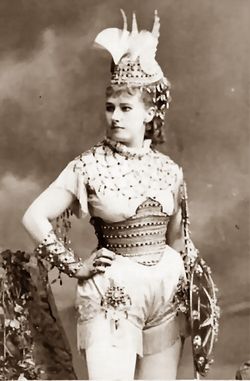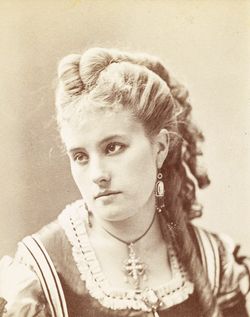Pauline Markham
Click here for Burlesque History page |
Pauline Markham (born Margaret Hall or Hale, May 1847 – March 20, 1919) was an Anglo-American dancer and contralto singer active on burlesque and vaudeville stages during the latter decades of the 19th century. She began by performing juvenile roles in Manchester, made her debut on the London stage at 20 and a year later New York as a member of the "British Blondes" which introduced Victorian burlesque to America, where for a few years she would find phenomenal success before her career settled into a long steady decline.
The critic Richard Grant White once described Markham's singing as vocal velvet and her arms as the lost arms of the Venus de Milo. Markham had studied singing with Manuel García at the Royal Academy of Music in London.
Pauline Markham was a singer and burlesque dancer during the period of Civil War in the United States. She was a member of the Lydia Thompson troupe.
She had relations with several famous Northern Generals and Reconstructionists after the Civil War.

This theatrical photograph from San Francisco shows Thompson troupe member Pauline Markham in a typical costume of a cuirasse bodice and tights. Lydia Thompson's troupe of similarly voluptuous dancers, called "The British Blondes," toured the country with The Black Crook, Ixion [2] The Man in the Moon, and other burlesques in the 1860s and '70s.
Emphasizing spectacular scenery, large casts, and women in tights, Thompson helped transform the burlesque in the 19th century from dramatic parodies or farces performed after the featured drama into the main feature. Thompson and her troupe parodied male characters and inverted gender definitions through cross-dressing, challenging prevailing notions of femininity. "The British Blondes" redefined notions of feminine beauty and autonomy, appealing especially to female audiences
References
- ↑ Sepia photograph from San Francisco: Houseworth's Celebrities, 186[6]
- ↑ https://en.wikipedia.org/wiki/Ixion,
External links
Chat rooms • What links here • Copyright info • Contact information • Category:Root
